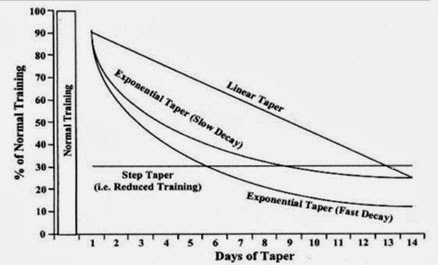It is common practice for elite and recreational athletes to
spend months, perhaps even years training in preparation for a specific
sporting event. However, the physiological and arguably the psychological gains
achieved by an intense training regime are useless if the exerciser does not
conduct an effective taper.
The first article of this month discussed the importance of
a long term training programme, the current article will serve well to complement
the previous issues raised and ensure even more refined physiological peaks are
achieved. The taper is a fundamental element to sporting preparation and can be
characterised as a mesocycle, within which the training stimulus sees a
significant reduction. This may be achieved in a linear or nonlinear fashion. The
aim of this practice is to minimise any fatigue accumulated during prior
training, whilst preventing the loss of relevant biological adaptations.
Therefore highlighting the need to maintain training but at a reduced level.
The taper should be exclusively tailored to an individual’s
preferences, as any reduction in training will also cause profound
psychological effects to occur. Such psychological stressors are due to the
absence of a structured lifestyle and increased time to over think performance,
both of which account for a greater pre-competition anxiety level that can be detrimental
to performance.
There are distinct patterns to tapering, these include a step taper, linear taper or exponential taper which involves a fast or slow decay of the training stimulus. During a step taper a sudden, standardised reduction in training can be observed and lasts for the full taper length. Alternatively, a more gradual decline in the training load can be seen in a progressive linear taper. Lastly, an exponential taper may be implemented, whereby a fast constant of decay elicits a rapid reduction in training load. On the other hand, a slow decay allows for a gradual training load reduction. The graph below displays these taper variations and the training load reduction one can expect to observe throughout its duration.
Current research indicates that a fast decay taper may
enhance athletic performance better than a slow decay, as this provides the
athlete with more time to overcome accumulated fatigue from the final weeks of
an intensive training regime. It is also thought that an advanced reduction to
training followed by a subsequent increase could further optimise performance.
The reasoning behind this practice is that the athlete would be able to take advantage of a
reduction in fatigue, effectively responding to training carried out during the
taper.
The effects one can expect from an effective taper include –
- Hypervolemia, this is an increase in blood plasma albumin content which provides the mechanism to metabolise greater amounts of fat.
- An increase in red blood cell production, meaning oxygen carrying capacity is greater and improvements to VO₂ max can be expected.
- Restoration of skeletal muscle and liver glycogen reserves, this is particularly prominent when coupled with appropriate nutritional techniques such as carbohydrate loading.
- A decrease in total mood disturbance.
- Increased muscular strength due to a greater maximum shortening velocity.
As a result of the physiological benefits brought about by
an effective taper, the mean expected improvement to performance time is
approximately 3% (Mujika and Padilla, 2003). This may seem like a fairly modest
enhancement, however it could reduce one’s half marathon time from 1:30 to
1:27, decreasing the average running pace per mile from 6:52 down to 6:38.
Finally, in order to achieve an effective taper a reduction
in training volume should be seen for a duration of two weeks, the intensity
and frequency of this training should be maintained to at least 80% of the pre-taper levels. This ensures the quality of training is not compromised but
sufficient recovery time can still occur. A fast decay, nonlinear taper design will
also mean no negative psychological responses occur that have often been
associated with step designs.

No comments:
Post a Comment